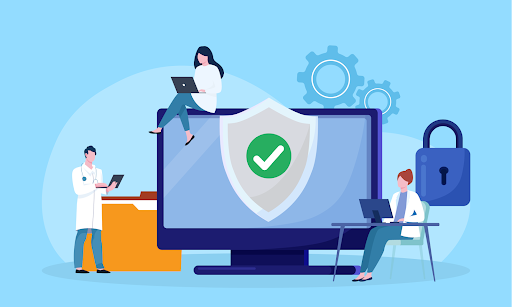Telemedicine has revolutionized healthcare delivery, allowing patients to access medical services from the comfort of their homes. The convenience and reach of telemedicine have been particularly beneficial during events like the COVID-19 pandemic, enabling continuity of care when in-person visits were restricted.
However, with the rapid expansion of telemedicine, various challenges and security risks have emerged, threatening patient privacy and the integrity of healthcare systems. Addressing these concerns is essential to ensuring the success and sustainability of telemedicine services. In this article, we will explore the common telemedicine challenges, the associated security risks, and strategies to mitigate them.
Common Telemedicine Challenges
Technological Barriers
Telemedicine heavily depends on technology. While telemedicine app developers are trying to improve digital products, not all patients or healthcare providers can access reliable internet or suitable devices. Older patients, rural communities, and those with limited digital literacy often face difficulties in participating in telemedicine consultations, creating disparities in healthcare access.
How to Avoid
- Improve Access: Healthcare organizations can partner with local governments to provide internet access to underserved areas or offer telemedicine consultations through low-bandwidth platforms.
- Digital Literacy Programs: Providers should create easy-to-understand tutorials and hold workshops to improve digital literacy, ensuring patients can use telemedicine platforms comfortably.
- Device Provision: Some organizations may consider loaning or providing affordable devices for telemedicine consultations to patients who lack them.
Quality of Care Concerns
Telemedicine limits physical interaction between the patient and the provider, making it difficult to conduct thorough physical exams. This may lead to diagnostic errors or ineffective treatment plans, particularly for conditions requiring hands-on evaluations or advanced medical equipment.
How to Avoid
- Set Clear Guidelines: Providers should establish when telemedicine is appropriate and when in-person visits are essential. This ensures patients are referred for physical consultations when necessary.
- Use Remote Diagnostic Tools: Providers can use wearable devices or home monitoring kits to gather real-time patient data, bridging the gap between virtual and physical assessments.
Licensing and Regulatory Compliance
Telemedicine introduces legal challenges as providers may serve patients across state or national borders, complicating licensing and regulatory compliance. Different jurisdictions have varying requirements, and failure to comply can lead to penalties or loss of practice licenses.
How to Avoid
- Stay Informed: Healthcare professionals should stay updated on telemedicine laws in the jurisdictions where they practice and treat patients.
- Telemedicine Platforms: Choose platforms compliant with relevant state, national, or international regulations, ensuring that cross-border practices remain lawful.
Reimbursement and Insurance Issues
Reimbursement for telemedicine services is still a growing field. Insurance companies may cover telemedicine consultations at different rates than in-person visits or refuse coverage altogether, making it difficult for providers to sustain telemedicine services financially.
How to Avoid
- Clarify Coverage: Providers should verify which services are covered by insurance before offering telemedicine services and communicate these details clearly to patients.
- Advocate for Policy Changes: Healthcare organizations should advocate for equitable reimbursement policies from insurance providers and government programs to support telemedicine.
Security Risks in Telemedicine
Integration of digital platforms into healthcare brings significant security risks. Sensitive patient data, financial information, and even medical outcomes can be compromised if these risks are not properly managed. Below is an expanded examination of the key security risks in telemedicine and how they can be mitigated.
Data Privacy Violations
Telemedicine platforms handle a large volume of personal health information (PHI), including medical records, treatment plans, diagnostic results, and personal identifiers like social security numbers. This data is highly sensitive and must be protected under regulations such as HIPAA in the U.S., GDPR in Europe, and similar laws in other regions. Any unauthorized access or accidental leakage of this data can result in privacy violations, potentially leading to identity theft, fraud, and a breach of trust between patients and healthcare providers.
Cyberattacks and Hacking
Telemedicine platforms, like any other online service, are susceptible to cyberattacks. Cybercriminals target healthcare data because of its high value in black markets, where stolen medical records can be sold for identity theft or insurance fraud. Cyberattacks such as ransomware, phishing, and Distributed Denial-of-Service (DDoS) attacks can disrupt telemedicine services, steal data, or hold healthcare systems hostage for ransom payments.
Third-Party Vendor Risks
Telemedicine services often rely on third-party vendors to provide critical components such as cloud storage, video conferencing, payment processing, and patient management systems. These vendors may sometimes adhere to different stringent security standards than healthcare providers. Any weaknesses in the security posture of these third parties can expose patient data to breaches or compromise the integrity of the telemedicine system.
Insecure Devices and Networks
Telemedicine consultations often occur on personal devices such as smartphones, tablets, or laptops, which may have a different level of security than devices within a hospital or healthcare facility. Patients may use insecure home networks or public Wi-Fi to access telemedicine services, increasing the risk of data interception by cybercriminals.
The Bottom Line
Telemedicine offers numerous benefits, from expanding healthcare access to improving patient convenience, but it also comes with its own set of challenges and security risks. Overcoming these challenges requires a proactive approach that combines technology solutions, patient education, and compliance with regulatory standards.
By understanding and addressing these issues, healthcare providers can offer safe, secure, and effective telemedicine services that meet the needs of patients while protecting their sensitive information. The future of telemedicine looks promising, but its success depends on how well these risks are managed.






